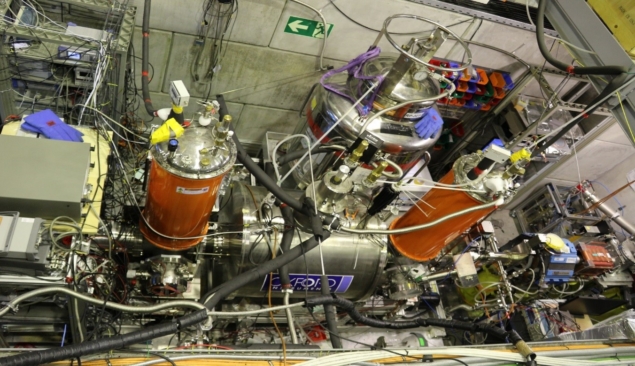
A first-of-its-kind experiment at CERN has brought dark matter and antimatter face to face. The fundamental nature of dark matter, inferred to make up around a quarter of the universe, is unknown, as is the reason for the observed cosmic imbalance between matter and antimatter. Investigating potential links between the two, researchers working on the Baryon Antibaryon Symmetry Experiment (BASE) at CERN, in collaboration with members of the Helmholtz Institute at Mainz, have reported the first laboratory search for an interaction between antimatter and a dark-matter candidate: the axion.
Axions are extremely light, spinless bosons that were originally proposed in the 1970s to resolve the strong charge–parity problem of quantum chromodynamics and, later, were predicted by theories beyond the Standard Model. Being stable, axions produced during the Big Bang would still be present throughout the universe, possibly accounting for dark matter or some portion of it. In this case, Earth would experience a “wind” of gravitationally interacting dark-matter particles that would couple to matter and antimatter and periodically modulate their fundamental properties, such as their magnetic moment. However, no evidence of such an effect has so far been seen in laboratory experiments with ordinary matter, setting stringent limits on the microscopic properties of cosmic axion-like particles.
Our ALP–antiproton coupling limits are much more stringent than limits derived from astrophysical observations
Stefan Ulmer
The BASE team has now searched for the phenomenon in antimatter via measurements of the precession frequency of the antiproton’s magnetic moment, which it is able to determine with a fractional precision of 1.5×10-9. The technique relies on single-particle spin-transition spectroscopy – comparable to performing NMR with a single antiproton – whereby individual antiprotons stored in a Penning trap are spin-flipped from one state to another (CERN Courier March 2018 p25). An observed variation in the precession frequency over time could provide evidence for the nature of dark matter and, if antiprotons have a stronger coupling to these particles than protons do, such a matter–antimatter asymmetric coupling could provide a link between dark matter and the baryon asymmetry in the universe.
“We’ve interpreted these data in the framework of the axion wind model where light axion like particles (ALP’s) oscillate through the galaxy, at frequencies defined by the ALP mass,” explains lead author and BASE co-spokesperson Christian Smorra of RIKEN in Japan. “The particles couple to the spins of Standard Model particles, which would induce frequency modulations of the Larmor precession frequency.”
Accruing around 1000 measurements over a three-month period, the team determined a time-averaged frequency of the antiproton’s precession of around 80 MHz with an uncertainty of 120 mHz. No signs of regular variations were found, producing the first laboratory constraints on the existence of an interaction between antimatter and a dark-matter candidate. The BASE data constrain the axion-antiproton interaction parameter (a factor in the matrix element inversely proportional to the postulated coupling between axions and antiprotons) to be above 0.1 GeV for an axion mass of 2×10−23 and above 0.6 GeV for an axion mass of 4×10−17 eV, at 95% confidence. For comparison, similar experiments using matter instead of antimatter achieve limits of above 10 and 1000 TeV for the same mass range – demonstrating that a major violation of established charge-party-time symmetry would be implied by any signal given the current BASE sensitivity. The collaboration also derived limits on six combinations of previously unconstrained Lorentz- and CPT-violating coefficients of the non-minimal Standard Model extension.
“We have not observed any oscillatory signature, however, our ALP–antiproton coupling limits are much more stringent than limits derived from astrophysical observations,” says BASE spokesperson Stefan Ulmer of RIKEN, who is optimistic that BASE will be able to improve the sensitivity of its axion search. “Future studies, with a ten-fold improved frequency stability, longer experimental campaigns and broader spectral scans at higher frequency resolution, will allow us to increase the detection bandwidth.”





